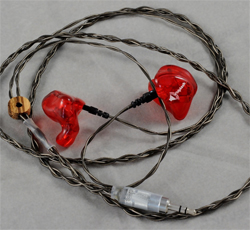If you read my writing with any regularity, you’ve probably noticed that in ear monitors (IEM) have been a recent hot topic.
I like them – no, I love them! But only when they’re used on the right person, in the right venue, and in the proper way.
This past weekend I was at a conference that hit almost every one of these points, yet I found the IEMs to actually be a nuissance.
The event featured a very good worship band (think Chris Tomlin and David Crowder combined, strange but it worked well), solid keynote speakers and 1,100 teens and adults.
The room was a nicely retrofitted sanctuary built in the 1980s, and new technology had been added to give it a nice flair. The video screen was well placed and looked good, the lighting and stage backdrop also looked good.
The PA sounded good – it was well designed and tuned. I was sitting in the second row and the stage lip loudspeakers and the house loudspeakers worked together really well.
.
On stage, the drummer was in an enclosed drum “cave” – Plexiglas front, padded rear, lid on the top and a door that sealed him in. (Ventilation must have been lacking as he was sweating profusely!)
There were no amps (guitar or otherwise) on stage, but I could see an ISO box for the lead guitar just off stage. All of the musicians (keys, acoustic, lead, bass, drums and the lead singer also played acoustic) had personal monitor mixers and wore in-ears – everyone hard-wired except the lead singer.
During the first session of the day, the lead singer would put his ear buds in and then pull one of them out, put it back in, pull it out – repeat, repeat, repeat. After a while, this really started to bother me. I was uncomfortable for (and with) him.
I thought perhaps he didn’t have an ambient mic in his mix, or his mix was bad (it would be his own fault with the Aviom control and wireless transmitter on stage right next to him), or perhaps the ear buds weren’t comfortable (not fitted properly?).
During the next two sessions of music, he followed the same process, taking one bud in and out. It was downright distracting!
Also throughout the day, the lead guitar player constantly adjusted the clip on the wire of his ear buds. It was on the back of his collar and held the wire in place.
I don’t know if the clip was poking him in the back of the neck or if he was just nervous – and his playing with it was a result of that – but it was also very distracting.
During the second set, the keyboard player grabbed an acoustic guitar for one song. As he was playing, now free from the restraints of having to stay at the keyboard, he proceeded to walk to the “end of his rope” and have the ear buds pulled right out of his ears. Again, very distracting.
Musically the band was quite, and minus the IEM issues, their stage presence was excellent.
One final distraction – earlier I mentioned the drum cave, and frankly, I’m not a huge fan of shields. In this room, with this style of music, and particularly with this heavy-handed drummer, the cave might have been necessary.
However, from where I was sitting, the snare drum sounded like it was going THUNK, THUNK. I was hearing way more low-mids than anything else.
I’m not sure how it sounded farther away – hopefully much better because you’d hear more PA and less of the sound that was leaking out of the cave.
My advice to all IEM users out there is to make sure that you’re comfortable with them before using them on stage. Because if you’re uncomfortable, you’re very likely to make your audience uncomfortable – or distracted at the very least.
Gary Zandstra is a professional AV systems integrator with Parkway Electric and has been involved with sound at his church for more than 25 years.


















